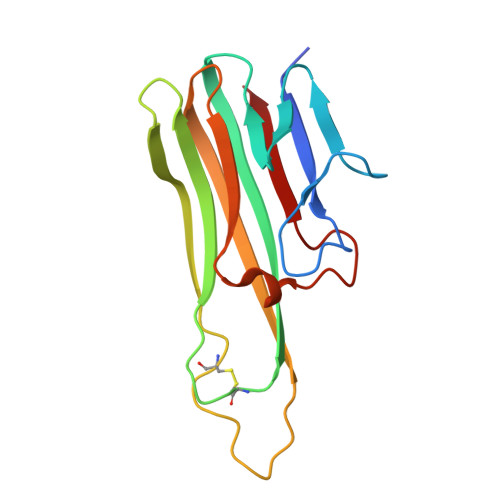Structure-based development of a canine TNF-alpha-specific antibody using adalimumab as a template.
Lee, C.C., Kuo, W.C., Chang, Y.W., Hsu, S.F., Wu, C.H., Chen, Y.W., Chang, J.J., Wang, A.H.(2024) Protein Sci 33: e4873-e4873
- PubMed: 38111376
- DOI: https://doi.org/10.1002/pro.4873
- Primary Citation of Related Structures:
8KB6 - PubMed Abstract:
The canine anti-tumor necrosis factor-alpha (TNF-α) monoclonal antibody is a potential therapeutic option for treating canine arthritis. The current treatments for arthritis in dogs have limitations due to side effects, emphasizing the need for safer and more effective therapies. The crystal structure of canine TNF-α (cTNF-α) was successfully determined at a resolution of 1.85 Å, and the protein was shown to assemble as a trimer, with high similarity to the functional quaternary structure of human TNF-α (hTNF-α). Adalimumab (Humira), a known TNF-α inhibitor, effectively targets and neutralizes TNF-α to reduce inflammation and has been used to manage autoimmune conditions such as rheumatoid arthritis. By comparing the structure of cTNF-α with the complex structure of hTNF-α and adalimumab-Fab, the epitope of adalimumab on cTNF-α was identified. The significant structural similarities of epitopes in cTNF-α and hTNF-α indicate the potential of using adalimumab to target cTNF-α. Therefore, a canine/human chimeric antibody, Humivet-R1, was created by grafting the variable domain of adalimumab onto a canine antibody framework derived from ranevetmab. Humivet-R1 exhibits potent neutralizing ability (IC 50 = 0.05 nM) and high binding affinity (EC 50 = 0.416 nM) to cTNF-α, comparable to that of adalimumab for both hTNF-α and cTNF-α. These results strongly suggest that Humivet-R1 has the potential to provide effective treatment for canine arthritis with reduced side effects. Here, we propose a structure-guided antibody design for the use of a chimeric antibody to treat canine inflammatory disease. Our successful development strategy can speed up therapeutic antibody discovery for animals and has the potential to revolutionize veterinary medicine.
Organizational Affiliation:
Institute of Biological Chemistry, Academia Sinica, Taipei, Taiwan.














